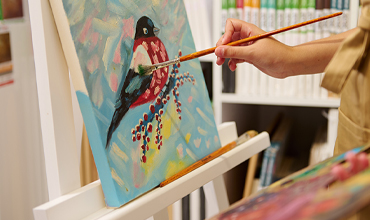When we think of school subjects, most likely the core academic classes of math, language arts, science and social studies come to mind. Often, the fine arts – music, dance, theater and visual arts – are an afterthought. These special subjects, however, can have a profound impact on our children.
Unfortunately, according to the National Assembly of State Arts Agencies, fine arts classes appear to be more of an afterthought in funding as well. Texas ranked 47th in funding for the arts in its 2023 fiscal year budget, which equated to a per capita spending rate of just 34 cents.
Parents need to be educated about the benefits of an arts education so that we can protect current spending levels and, ideally, advocate for increased spending in these areas. We can also be creative about how we support the arts programs in our children’s schools, fundraising for materials and other needs and volunteering our time.
Some of the benefits our children receive from fine arts courses include:
Greater school engagement and performance. According to the Texas Cultural Trust, students enrolled in fine arts courses not only attend school more regularly (the equivalent of an extra week of school each year) but those who complete more fine arts classes have up to 15% higher passing rates on standardized tests than students with fewer fine arts classes.
Improved mental and emotional well-being. The arts provide an outlet for students to express their emotions and present an opportunity to shift into mindfulness in what can otherwise be a stressful day. It is a time in the day when students can relax and have fun, without worrying so much about a grade or getting the final product “right.” Participating in the arts can reduce anxiety and improve mood, allowing students to return to their academic classes more centered and ready to learn.
Social and emotional learning opportunities. Classes that focus on collaboration, such as music and theater, provide a natural way to work on communication with peers. According to a study conducted by the John F. Kennedy Center’s Changing Education Through the Arts Program, teachers who provided their students with consistent access to the arts reported a “more positive and cohesive” learning environment, owing to improved peer collaboration and better social skills in the classroom.
Heightened creativity. Academic subjects often require students to deal primarily with facts. The arts certainly do include facts, such as how to measure time in music or the dates of various periods in art history, but they are also rich with opportunities for creative expression that can be lacking in academic subjects, particularly in upper-grade levels. These classes can be a welcome reprieve for students, especially those who love flexing their creative muscles.
Improved focus and attention. Whether it is working on memorizing lines for a play or carefully mixing paint colors to achieve the desired result, the arts require students to focus and attend to what they are learning in a way that traditional academic classes may not. Because students are taking an active role in the learning process, they are less able to “zone out” and, as a result, they strengthen their abilities to attend and focus on the work at hand. These skills can often translate into other classes and to home life.
Inherent differentiation. There is one answer to a math problem and only one date that the Constitution was signed. There are, however, seemingly endless ways to draw a still life, perform a theater piece or use your voice in song. For those students who are not traditional learners, the arts offer a place to participate in the way that works best for them and best expresses their ideas.
Improved self-confidence. True self-confidence comes from accepting new challenges and developing new skills that one can reflect on with pride. The arts offer myriad opportunities for students to push themselves and take pleasure in their new abilities and accomplishments.
Cultural exposure and awareness. The arts often highlight different cultural traditions. Learning about various cultures helps students to better understand and appreciate others’ cultures and, by extension, fosters a sense of empathy and respect for differences.
Career preparation. Fine arts education teaches skills that will be valuable to students when they are ready to join the workforce. Collaboration, communication, problem-solving, perseverance, focus, creativity and innovation are all skills that are desired by hiring managers in a wide range of fields.
It was only when I started learning more about the profound impact that the arts have on our children that I began to truly appreciate just how important, and necessary, these classes truly are. They are more than just a break from learning, they provide incredible learning opportunities themselves. We must challenge ourselves to stay aware of and engaged in how the arts are funded in our children’s schools. All children deserve the richness of a fine arts education.
Alison Bogle is a writer living in Austin with her husband and three children. A former fourth grade teacher, she now enjoys writing about children and education. You can also catch her talking about articles from Austin Family magazine each Thursday morning on FOX 7 Austin.














